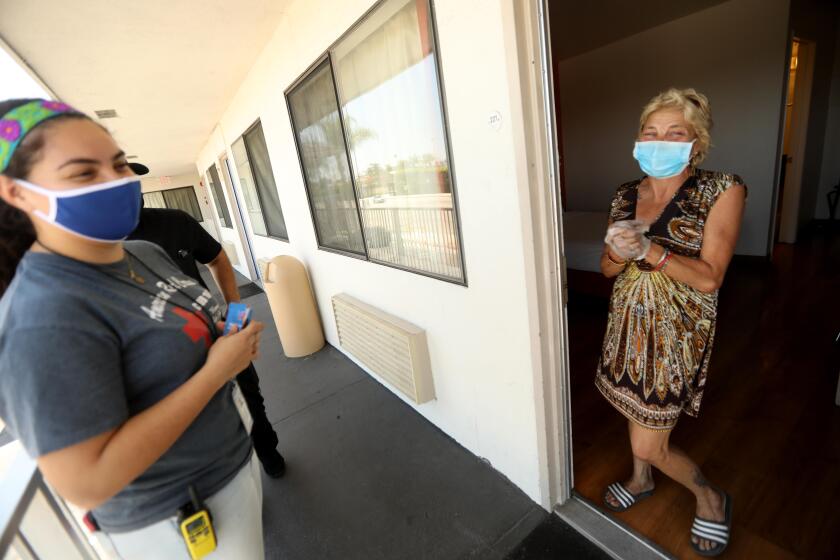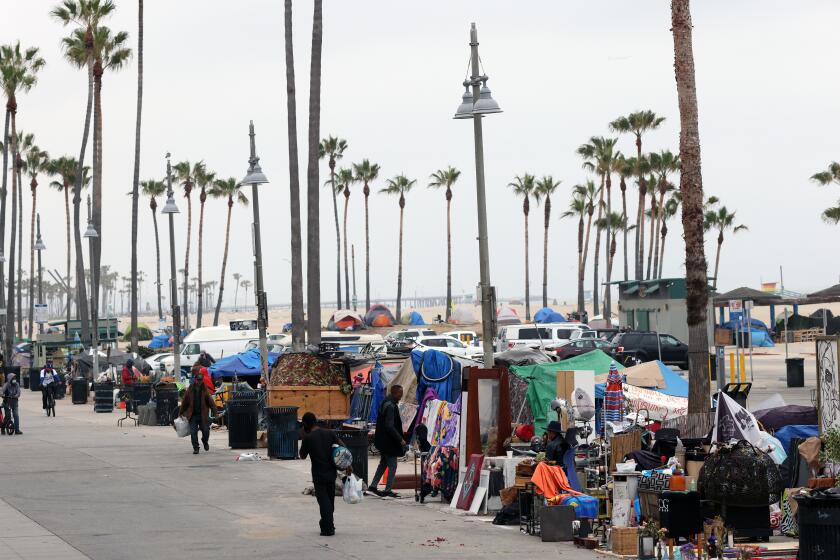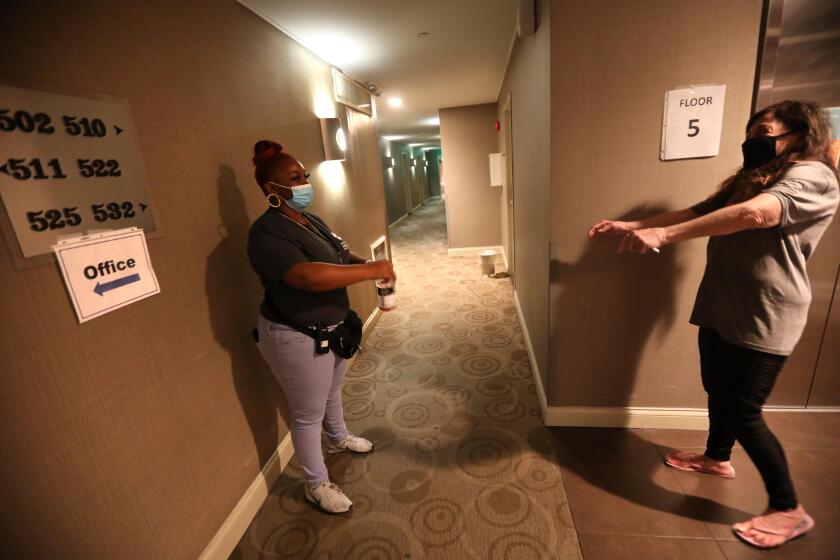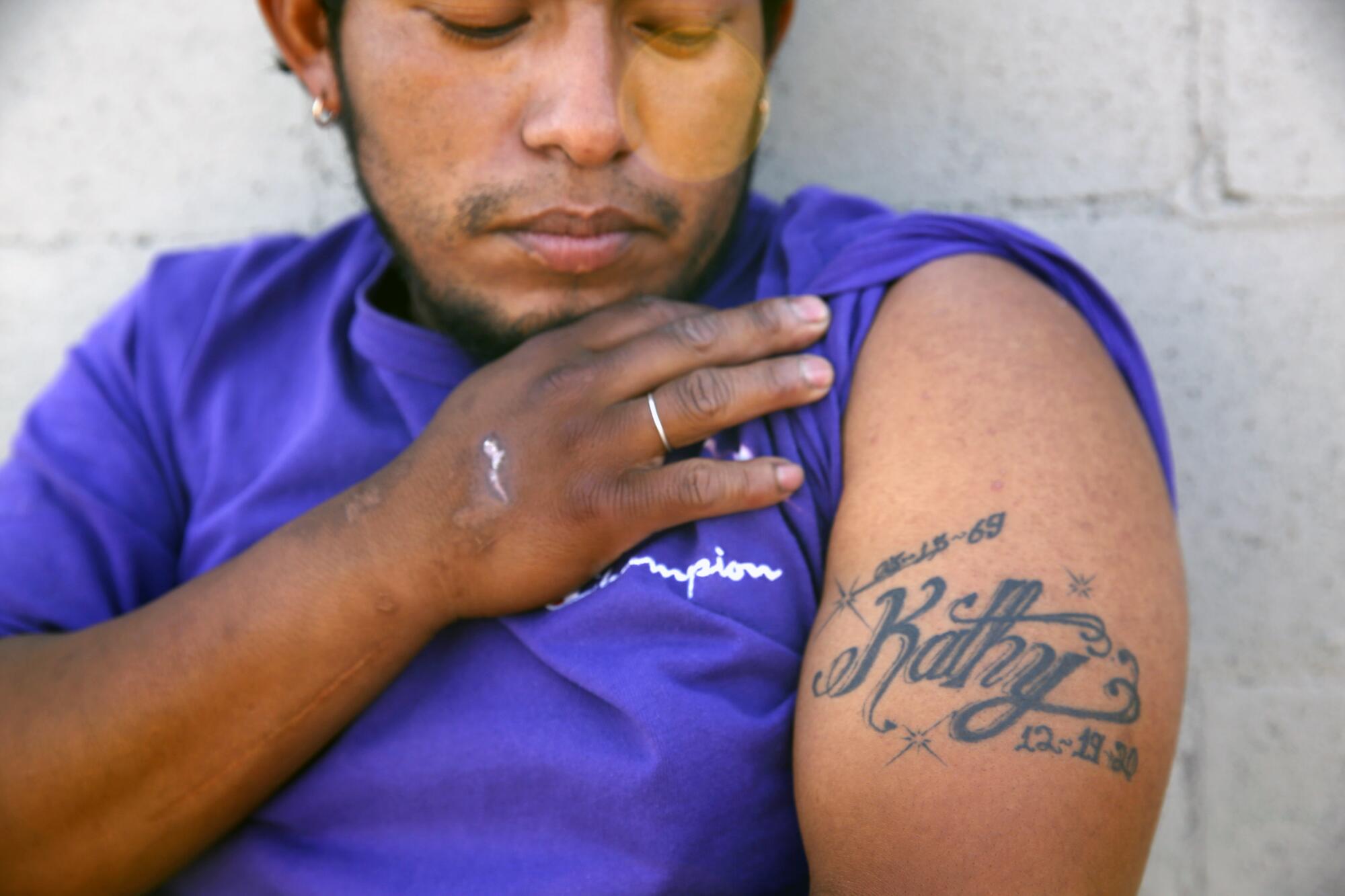
- Share via
Days before her death, Kathy Vandiver seemed to be faring better than her daughters had seen in years.
After years of addiction and struggle, she had gotten off the streets of the San Fernando Valley and into a hotel room through Project Roomkey. She was talking about getting an apartment soon; she was bringing over friends to say hello on a video chat. She had a loving boyfriend. She had plans, once a check came through, to visit family in Illinois.
She seemed healthy and happy, her daughter Karla Benitez thought. Like the mother she remembered as a kid.
“How could she just die like that?” Benitez asked.
Vandiver, 51, was one of at least eight people who died while they were living at the Airtel Plaza Hotel, according to data provided by the Los Angeles County coroner and the Los Angeles Homeless Services Authority. During the pandemic, hundreds of homeless people have been housed at the sprawling hotel and conference center outside Van Nuys Airport through Project Roomkey, a government program aimed at the vulnerable population.
The deceased were young and not so young, Black and white, local and transplant. Several lost their lives to heroin or methamphetamine at the hotel, according to coroner findings. Vandiver died of an intracerebral hemorrhage after being found unconscious in her room and taken to the hospital, though medical examiners found that medical conditions and methamphetamine use were “contributing conditions” to her death.
One death at the hotel was labeled as natural — a 41-year-old man found to have died of coronary artery disease. And one participant died of natural causes away from the site, according to LAHSA records.

What happened at the hotel is a reflection, in some ways, of the dire vulnerability of the homeless people who went there, and the maladies and addictions that can be exacerbated by living on the streets.
But the death toll also raises questions about whether providers could better protect people as they move from the streets into hotel rooms and other shelter. L.A. County’s top doctor responding to homelessness said it also underscores the lack of spaces where people with serious mental and physical ailments can go for care in Los Angeles.
“We need a place for people who aren’t just physically ill,” said Dr. Heidi Behforouz, medical director for the county Housing for Health program. “It’s for the people who are traumatized, or in the midst of substance use disorder, or are having a mental health moment, and just need some wraparound attention and stabilization. Our system is missing that.”
The Airtel is not the only Project Roomkey hotel where people have died. As of this spring, 49 deaths had been recorded among people who were living in Roomkey hotels, out of the thousands of people participating in the countywide program, according to LAHSA statistics. The majority of those deaths occurred on-site. LAHSA did not provide a breakdown of their causes of death beyond whether they were categorized as natural, unnatural or undetermined.
The Van Nuys hotel, which had the highest number of deaths, was also one of the biggest sites in the program, with an average of nearly 300 people bedding down there nightly. Its per capita death rate was higher than average among Project Roomkey hotels, although not the highest in the program, a Times analysis found.
Eliel Fuentes said that before he and Kathy Vandiver got into the Airtel, her health had already been suffering. The two had met at a Little Caesars three years ago and not been apart since, he said.
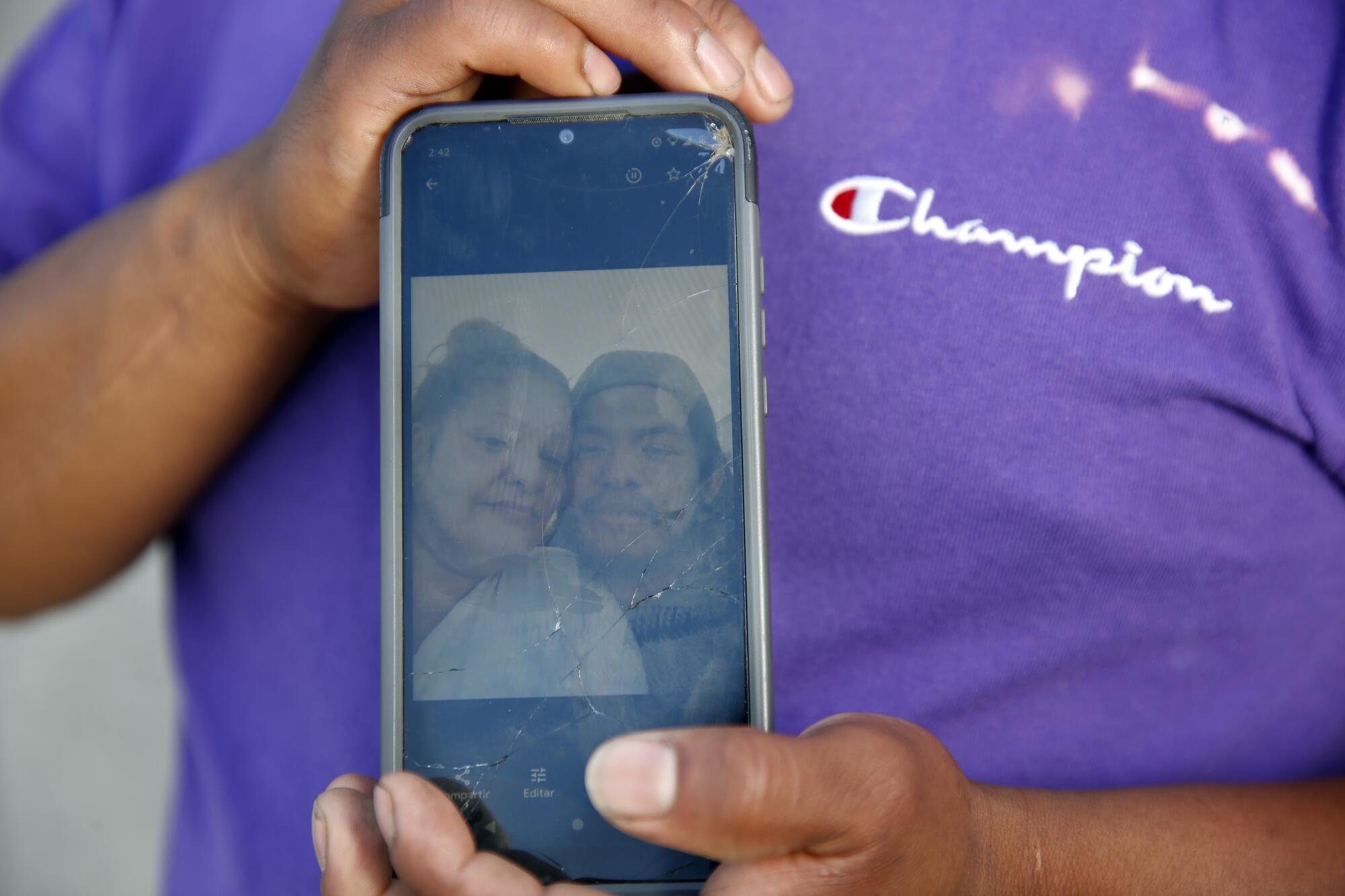
They had been living in a Van Nuys motel when the pandemic began, but Fuentes lost his job in a restaurant and they ended up living along the Metrolink tracks. It had been especially rough on Vandiver, who suffered from heart problems, he said. Ironic for a woman whose heart was so big, Fuentes said, that she would give away whatever she had.
At the Airtel, “we were very happy together,” Fuentes said.
Project Roomkey is a statewide program launched in spring 2020 to provide rooms to the homeless people most vulnerable to hospitalization or death from COVID-19. At the program’s peak, the city and county were sheltering more than 4,300 people, but it was scaled back to fewer than 2,000 this winter amid concerns that the federal subsidy would end.
This spring, however, several hotels were reopened and new ones were leased. The Airtel was initially opened by the county as a Roomkey site under one operator, closed at the end of March amid concerns about managing its vast site, then reopened by the city in April under a new operator.
Members of a new group, Unhoused Tenants Against Carceral Housing, have demanded changes to the program, complaining that Project Roomkey participants have been subjected to restrictive curfews, harassment, intrusions on their privacy and punitive rules at sites that they likened to jails. One woman said a friend died by suicide after suffering isolation in a Roomkey hotel.
Former Airtel residents interviewed by The Times had a range of complaints about their experiences, many revolving around their treatment by program staff. Abra Marshall, who complained to a state agency about being groped by a security guard, said she had suffered a miscarriage at the Airtel because of stress and harassment.
Another former Airtel resident, Jennifer Blake, said the staff had neglected to send a nurse to check on her, as promised, after she measured her own blood pressure and found it was spiking.
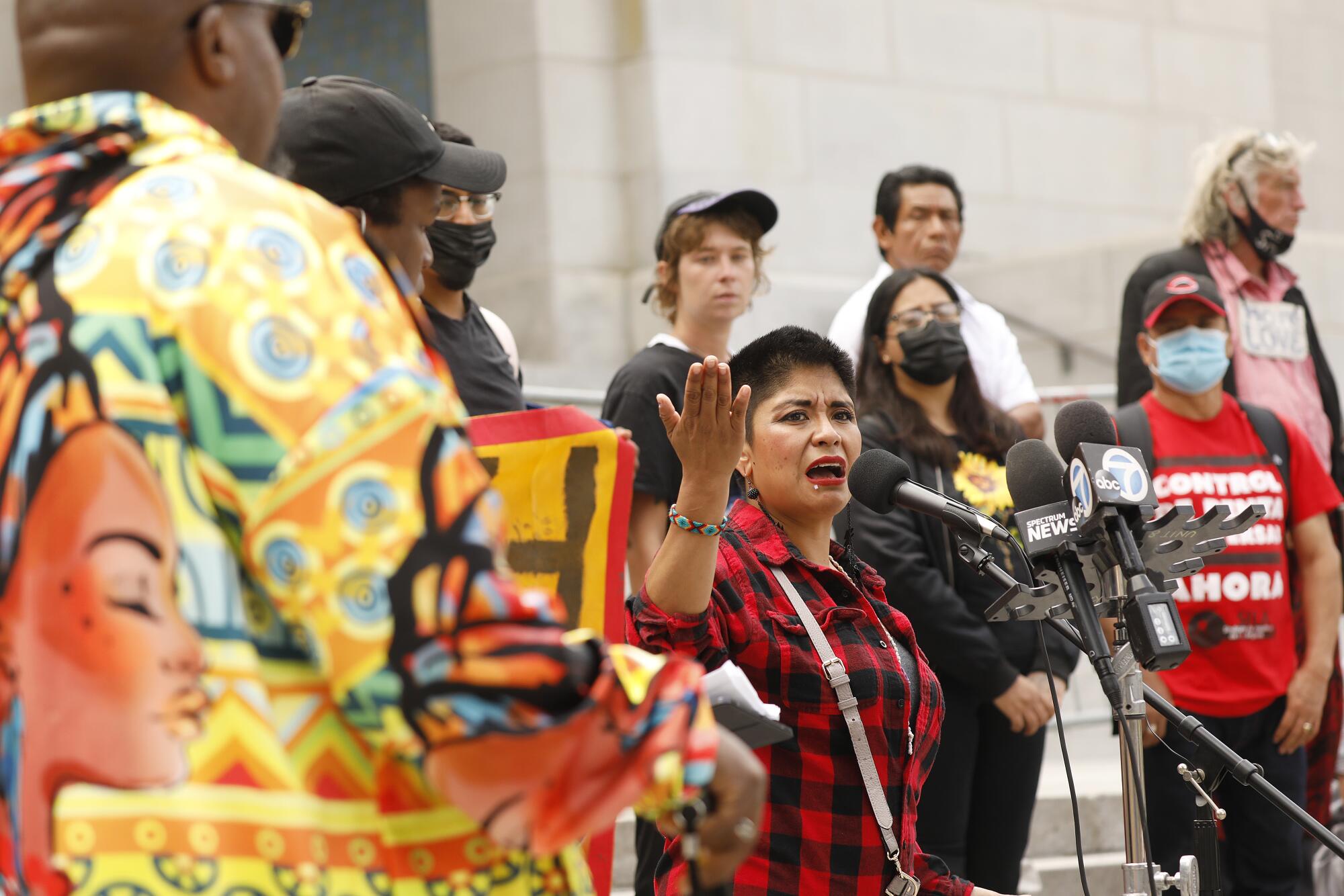
“How can … that many people die in a place where they are supposed to be caring for your well-being?” Blake asked at a May news conference on the steps of City Hall. Blake, who moved into another Roomkey hotel after staying at the Airtel, concluded her remarks by saying, “To tell the truth, I would be better off if I had stayed on the streets.”
Among those who knew Vandiver was Paul Read, co-founder of the homeless support group Passion. He did not fault the program operators at the hotel for the deaths, saying that if the homeless people who found shelter at the Airtel had been left in secluded encampments, “more probably would have died.”
In the Sepulveda Basin, where many of them came from, “there’s fires. There’s flooding. There’s so much disease. It’s tough for EMTs and help to get down there, whether it’s flooding or an overdose or they’re sick,” Read said.
The county will keep 11 of its 12 Project Roomkey sites open through September, but budget constraints will keep it from expanding the program.
After the program opened, emergency medical technicians showed up to the Airtel, on average, nearly every other day, according to L.A. Fire Department records. Last July — the same month that two men died at the hotel — EMTs were sent to the Airtel nearly two dozen times, including four visits on the same day.
Homeless people sheltering at the Airtel died at a moderately higher rate than unsheltered people across the San Fernando Valley last year, The Times’ analysis found. But Project Roomkey was supposed to target the people at greatest risk during the pandemic, complicating such comparisons.
“We can never measure how many lives are saved because people are indoors,” LAHSA Executive Director Heidi Marston said. But the vulnerability of those residents underscores that, in some cases, “there is a need for a different kind of wraparound healthcare services to be made available to folks.”
::
Kenneth Colato was better known as Rabbit to people living in the remote reaches of the Sepulveda Basin, where lush greenery runs into a concrete-covered river bed. Richard Silva said he had met Colato years ago when he became homeless and was living in the secluded area known as “the Bamboos.”
Colato wasn’t “really outgoing, but if you knew him, then you were in,” Silva said. “He would do anything for you.”
Colato was born and raised in the San Fernando Valley, had been in and out of prison, and long struggled with addiction. He told The Times last year that he first tried heroin as a 15-year-old while locked in a juvenile detention center. His body was emblazoned by gang tattoos that he had collected during his time in prison.
During the COVID-19 pandemic, homeless encampments grew dramatically in Echo Park and Venice Beach. What are the root causes driving Los Angeles’ homelessness problems?
He lived under the elevated Orange Line busway, where he had set up a bed and couches and would sometimes hold court, cracking jokes or playing the drums. “I don’t want to live like this,” he told The Times while he was living in the basin. “But I don’t know any other way.”
Silva remembered him helping people move their belongings or hunt down a stolen bike. Sometimes Rabbit would be walking dogs, “and it’s not even his dog,” Silva said.
“He’d give you the shirt off his back,” Silva said. “He would help you out and not even expect anything in return.”
When the pandemic began, Colato and others living in the basin were relocated to the Airtel. In March, he was found dead in his room, according to homeless people who knew him. The coroner had not released a report on his death as of late June.
Silva said he broke into tears when he heard the news. “I haven’t cried about too many people,” he said. “He’ll be well missed.”
::
L.A. Family Housing Chief Executive Stephanie Klasky-Gamer, whose nonprofit was the first to operate the program at the Airtel, said that many homeless people had come to the Van Nuys hotel straight from encampments, most of them along the rugged Sepulveda Basin, “a population that was deeply, deeply removed from services,” she said.
When they arrived at the hotel, some were struggling with addiction. Like many homeless service providers, L.A. Family Housing said it follows a policy of harm reduction — practical strategies that aim to minimize the harmful effects of drug use. Drugs were not allowed on-site, but people were not ejected from the program for breaking that rule, she said.
Klasky-Gamer said that Tarzana Treatment Centers had staffers at the Airtel and that lives had been saved by distributing Narcan, a nasal spray that delivers naloxone to reverse an opioid overdose.
“We believe there were likely fewer deaths from this group of participants while they lived at the Airtel than there would have been had they continued to live in the Basin this past year,” she said in an email.
But some unhoused people staying at the Airtel didn’t know they could ask for Narcan, said Carla Orendorff, a Street Watch L.A. organizer active in the Valley. Orendorff said that when the activist group was distributing the nasal spray, some residents mistakenly believed it was illegal to possess.
Rebeca Chavez, a former resident of the hotel, said that a friend who had asked for Narcan one evening at the hotel was told to come back in the morning to take a class first.
“They had boxes and boxes of Narcan downstairs. If there had been one or two boxes in every room, it could have been prevented,” Chavez said of the overdose deaths.
Unhoused Tenants Against Carceral Housing has included, among its demands, “clear and easy access” to Narcan.
Klasky-Gamer said that stocking rooms with the spray or leaving it out for residents would not encourage people to get training on how to use it safely, a “best practice” for distributing it. She said, however, that Airtel residents had still been provided Narcan even if they refused such training.
Orendorff said the clearing of encampments also broke up some of the familiar networks that people relied on for safety. “People check on each other very regularly in encampments. They know something isn’t right very quickly,” Orendorff said. In the hotels, “people were not able to check in on each other in the same way.”
The Times heard from former residents that a Project Roomkey participant was not found promptly after his death. Klasky-Gamer said that in one instance, nursing staffers contracted by the county to do wellness checks had knocked on a door and gotten no answer, but had been afraid to enter the room for an entire day because the man had a pit bull.
L.A. Family Housing staffers ended up going in themselves, she said, after his friends said they hadn’t seen him in two days.
::
‘I thought everything was going good for him. He was a nice, good-looking boy. He just took the wrong path.’
— Bill Silvers on his son, Ryan Radoff, who died at the Airtel
Drug addiction had derailed the life of Ryan Radoff, 38, who died at the Airtel in August, his father said.
Bill Silvers recounted jobs that Radoff had lost and said he had picked up a criminal record from “foolish things he did.” Silvers said he tried to help his son by offering up a home and, later, a new tent and supplies.
When he was younger, “he did everything with me,” Silvers remembered. “We worked on cars together. We had boats. Everything was really good. His friends came over and they were swimming in our pool. He had birthdays. Everything was normal…. He had everything. I don’t know what he was thinking.”
After Radoff died, Silvers said he learned from a receipt in his son’s wallet that Radoff had gone downstairs the night of his death and taken out $200 from an ATM at the hotel.
Silvers said he was told that the cash wasn’t there when Radoff died early in the morning at the Airtel, the cause of death ultimately listed as “effects of methamphetamine and heroin.”
Radoff’s girlfriend called Silvers crying the next day, after he had already heard the news from authorities. She had stumbled over Radoff’s body around 3 a.m. when she got up to go to the bathroom, according to a coroner’s report obtained by The Times. Someone at the hotel tried to revive him with naloxone, the report said. Paramedics tried too. It didn’t work.
At the Airtel, “I thought everything was going good for him,” Silvers said. “He was a nice, good-looking boy. He just took the wrong path.”
His ashes were scattered at sea off San Clemente, along with those of his grandmother, who had died two weeks earlier in a care facility amid a COVID-19 outbreak. Silvers saved a little bottle of ashes and sent it to his son’s girlfriend.
::
Whether on the streets or in hotels, one of the drivers of deadly overdoses is using drugs alone, said Darren Willett, director of the Center for Harm Reduction run by Homeless Health Care Los Angeles. Willett said he wasn’t assessing what happened at any site, but “the criminality associated with drug use creates the desire to hide no matter where you are.”
“The more comfortable people feel about sharing the fact that they’re using drugs, the more access they have to naloxone and the more able they are to use in the company of others, you’re going to see reduced overdose rates,” he said.
Another recognized risk factor for overdoses, Willett said, is mixing drugs or trying more powerful ones. Karen Lewis, a Project Roomkey participant at the Airtel, said deaths coincided with “a big change from people doing heroin to doing fentanyl.”
Subscribers get early access to this story
We’re offering L.A. Times subscribers first access to our best journalism. Thank you for your support.
Before she moved off the streets and into the Airtel, she said, “I administered Narcan to probably eight people. That was the beginning of everybody switching.” At the hotel, she added, “the dealers were very convenient.”
Fentanyl drove a spike in deaths of homeless people across L.A. County last spring, a county Public Health Department report found. But medical examinations of people who died of overdoses at the Airtel did not detect fentanyl, according to coroner reports available as of early June.
Kim Olsen, a board member with the mutual aid group West Valley Homes Yes, said the reason so many died at the Airtel was “the same reason they’re dying on the street.” (The leading causes of death among homeless people, according to a L.A. County study released this year, have been drug overdoses and coronary heart disease.)
At one point, Olsen said, she drove someone to the Airtel while an ambulance was bringing someone out on a gurney. “We were both shocked,” Olsen said. Still, “it did not discourage this person from checking in. Honestly, it was a very hot day and living outside was a far greater threat for someone with medical conditions.”
What troubled her, she said, was that “if we had a bunch of wealthy people at the Beverly Hills Hotel overdose, there would be an investigation. We would try and find who was selling that. And we would try and stop them.”
A Los Angeles Police Department spokesperson said its narcotics division had not investigated drugs at the Airtel.
::
The phone call from California gutted Bernetta Brown Simpson.
Her 41-year-old son, Andre, had been deeply intelligent and bookish as a teenager, a fan of science fiction and vampire novels. When he graduated from college, he had wanted to go to Korea to teach English.
Then it began — what his mother called a “mental break.” His thinking became strange, paranoid and troubled. He began to push away from his family. He left New York for California. Maybe, his sister thought, he wanted to be someone new.
Andre Michael Brown was found dead on a February afternoon in his room at the Airtel, the cause of death listed as coronary artery disease. During a welfare check by someone working at the hotel, he was found “unresponsive and wedged between the bed and a nightstand,” according to a coroner report.
Before he died, Brown had been hard to reach for his family on the East Coast. Simpson lamented that “we didn’t even know where he was half the time.”
“You could call him and leave messages, but he would pick and choose when he wanted to speak to somebody,” his sister, Adreian Simmons, said. “You don’t know what’s going on. And there was nobody we knew out there.”
After his mother heard that he had died in the Van Nuys hotel, her pained thoughts circled back to his journal. She wondered where it was and whether it could explain anything about the death of her son. As of late June, the family had not received any journal from authorities.
::
Caring for homeless people can be especially challenging because they often have ailments that have gone untreated for long periods of time, said Behforouz, the medical director for L.A. County’s Housing for Health program.
During the pandemic, her team has run several quarantine and isolation hotels, which are separate from the Project Roomkey sites. When a person was admitted, a team that includes a nurse, case managers and a social worker assessed their level of trauma and need, which “could help us understand the intensity of the services they needed.”
If someone was especially vulnerable — including drug users at risk of overdose — “you got checked up on much more frequently, and if you didn’t answer the door, we knocked down the door or used our master key,” Behforouz said.
No one died of an overdose at the sites overseen by her team, Behforouz said, a fact that she attributed to the high staffing and intensive assessment at those sites. Project Roomkey has been an incredibly valuable tool to get people off the street, she said, but it simply does not have the same level of staffing or screening as sites that had their services plan designed by Behforouz’s team.
Jeremiah Curry, who previously worked for L.A. Family Housing at the Airtel, said that some of the people hired to work at the Project Roomkey site were not properly trained or sensitive to the needs of a vulnerable population.
Despite facing a budget shortfall, Los Angeles hasn’t applied for millions in reimbursements for money spent to house homeless people amid the pandemic.
“A lot of people just saw it as being an easy job. It wasn’t an easy job. You’re responsible for people’s lives,” including people with underlying health problems and mental illness, Curry said.
“They didn’t pay attention to the telltale signs of what was going on,” he said.
Klasky-Gamer said dozens of new employees were hired to work at the Airtel, adding that although L.A. Family Housing had hired some staffers who were new to the field for Project Roomkey, all those hired had “a passion to help people” and were provided information on trauma-informed care, harm reduction and naloxone, among other topics.
A training video covered information on working with the population, she said. Besides the L.A. Family Housing team, there were others on-site, including nursing and security staff contracted by the county.
The program run by L.A. Family Housing at the Airtel was eventually shut down by the county, in part due to the high costs for maintaining security on a sprawling site with multiple entry points.
When the site reopened for Project Roomkey in April — this time through the city — it was surrounded with a fence. Orlando Ward, public affairs director for the new operator, Volunteers of America, said the fence was meant to ensure a “controlled entry” in reaction to security issues.
Chavez, who once lived in the Airtel, has since moved into a Canoga Park motel that was converted into housing. She felt good about where she was, finally more stable after years of homelessness. No one, she said, is made for the streets.
But she still found it hard to talk about the people who died at the Airtel.
“To see them there one day and gone the next — it’s still kind of hard for me,” she said.
More to Read
Sign up for Essential California
The most important California stories and recommendations in your inbox every morning.
You may occasionally receive promotional content from the Los Angeles Times.
